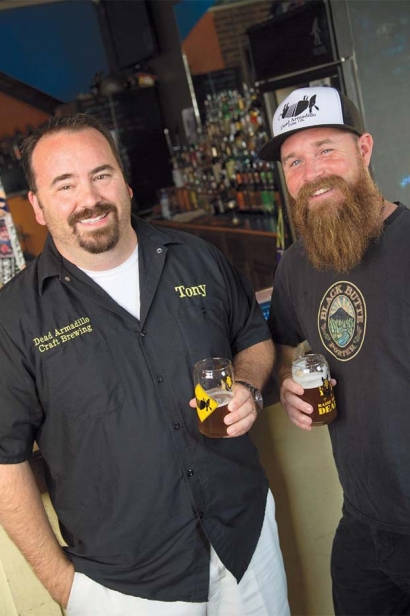Dead Armadillo Brewing Co. Has Big Plans On Tap in Tulsa
Tulsa’s most exciting new brewing company, Dead Armadillo, can be referred to with the same terms one might use to describe what I consider to be their best beer—and I’m referring here to the year-old company’s sophomore success story, their impressive Black Hop IPA. Words I come up with are bold, ambitious, unexpected. So yes, by my metric, this beer, and the brewers who make it, are worth keeping an eye on.
The duo of Mason Beecroft and Tony Peck launched their first official commercial distribution as Dead Armadillo in Tulsa during June 2013. Throughout that first year-and-ahalf of production, they have primarily been known for their American Amber Ale—the first recipe produced by the company during its initial days as a home-brewing endeavor operating, quite often, out of Peck’s garage.
There have been other brews, but owing to the limited capacity of their old facilities, they so far have been limited to small batches for special, local events, like Oklahoma’s Wild Brew festival. They also have a beer branded in collaboration with the Tulsa Athletic Soccer Club—an English bitter–style session beer called the Dead Ball Hooligan.
But it’s that Black Hop IPA that entices me most, and makes me fixate on this brewery. The tasting notes that inspired this interview are laudatory: “Huge head. Black color.
Smells of coffee & dark chocolate—like 80% cacao. Peanut butter. Toffee. Smoke. It tastes awesome.”
Save for the seasonal El CuCuy brew from Marshall’s Brewing Company, few to none in Oklahoma are commercially making Black IPAs—and no one does them on a schedule of year-round availability but Dead Armadillo.
The style has only recently been recognized by the Beer Judge Certification Program (a respected beer standards and styles guide) as being worthy of its own distinct categorization— that being, Cascadian Dark Ales. (They can also be known as India Black Ales, or simply Black IPAs.)
And starting in the beginning of 2015, they’ll be brewing it full time and on a larger scale than ever before in their new headquarters at the corner of 4th and Madison, right in the shadow of downtown Tulsa.
“The one great thing about [American brewing],” said Beecroft, “is that unlike the Germans or the English, we have the freedom to do whatever we want to do—and Black IPA is a style that came out of that.”
He described the style as having a heavy malt background, balanced out with lots of hops, making for a uniquely double-pronged drinking experience with a finish of earthy citrus. Brew Your Own magazine similarly referred to the style in 2010 as “a big, dark, hoppy beer of proportions that certainly puts it in a classification of its own,” back when it was still gaining notoriety around its popular origin in the Pacific Northwest.
So, it’s distinctive, a kind of its own. What made the folks at Dead Armadillo want to pursue that recipe for their sophomore eff ort? “We liked it,” said Beecroft (who hails from Oregon), chuckling at the simplicity of their motives.
“It was my favorite recipe that we’ve done,” added Peck. “We were very comfortable with that recipe, which, honestly, is why we’re talking about doing the Nine Band IPA [next]—because second to everything else, it’s probably the thing we’ve brewed the most of.”
Also taking elements of Northwest-style brewing not too common for Oklahoma, their Nine Band IPA is the de facto next in line for wider production at Dead Armadillo. It’s uniquely brewed by layering hop additions on top of each other over the course of a 90-minute boil, and it has found success on the festival scene. They use nine additions of hops in the process of making it—hence the name, Nine Band IPA.
“It also has a nice malt back to it, so it’s not like you’re getting kicked in the face with that hop bitterness,” said Beecroft. “Not that I mind that.”
The two met when Peck and his family began to frequent Tulsa’s Grace Lutheran Church at 5th and Lewis several years ago. Beecroft was the minister.
“Are you serious?” I asked here, regarding the bearded, grizzled, trucker-hat-wearing man smiling in front of me and nodding.
“People are always shocked.”
“He didn’t have the beard,” Peck said helpfully, pressing on. “So we started going to church there, and Mason actually baptized [my son]. He’s baptized both my children, actually.”
“I would hold classes in the summer,” said Beecroft, “and the church would have events. I would brew beer and bring it.” So while children convened for the church’s Bible school for a few hours of the day, Beecroft would put on a decidedly diff erent clinic for their adult caretakers in the backyard, sharing tips on the art of craft brewing to any and all who were interested.
“The parents would drop the kids off , and all the parents would come out to the back patio, and we’d sit back there and drink beer,” said Beecroft of his lessons. “I called it the Christian Art of Brewing Beer.”
“Three hours, drink beer,” said Peck. “That’s when I learned to brew—2006. He taught me.”
So while Dead Armadillo may be a young brewery in an official capacity, the seeds of its creation have long been rooting, with Beecroft taking his first steps into the trade during the late ’90s. His first recipe formed the basis of what would eventually be sold as the company’s American Amber Ale.
“I’ve tweaked it,” he assured me.
Part of that tweaking has come as a result of the shifting scale of operations between home and commercial brewing—the diff erences in efficiency with the equipment involved in each process necessitates all kinds of changes. But another part of it has simply been the long process of feeling out a recipe, angling toward producing the best beer possible.
Their years spent advancing their craft from hobby to business have apparently been characterized by an easygoing, gradual escalation of ambition.
“We couldn’t have even planned for it,” said Beecroft of how the company had come to be. “I taught [Tony] how to brew eight years ago, and he came to me a few years ago and said we should consider doing a brewery. So it started out as a bad idea.”
They attended the Oklahoma Wild Brew Festival as home-brewers for the first time in the late summer of 2012 with their recipe, and recall the experience fondly.
“The line was insane at our booth,” said Peck. After that first experience, at which they were called Dead Armadillo in an unofficial capacity, operations amplified considerably. They raised capital through every possible fundraising method, using cash of their own, raising cash from investors, and even hosting a successful Kickstarter drive to defray the costs of kegs and merchandise. That drive wrapped up in May 2013; by June of that year, they were in business officially.
When I spoke to them, they were still waiting on a litany of bureaucratic blockades to be bypassed on the way to approval for their new digs at 1004 E. 4th St. The waiting, eff ort and runaround however, will all be worth it in the end for what this new facility can off er them. For instance, in their first year, Dead Armadillo’s facilities could only produce three batches a month of, say, the Amber Ale—or roughly 30 barrels of beer. With their new building, they hope to have the space and equipment to have 10 to 15 of those batches ready to go from the first day forward.
Another goal they have in their immediate sights is to use the increased capacity of their new headquarters to produce varieties of beers brewed at a max of 3.2% alcohol by weight , in concession to Oklahoma’s restrictive liquor laws. It is these laws that prevent anything above that limit from being sold chilled in stores, or say, self-distributed to the public under your own roof from your very own taps.
For this front-of-house taproom, Peck envisions “a whole wall of six to eight diff erent 3.2% beers,” as well as ample space in the people to watch TV, drink and relax.
“We were always going to do a low-point beer,” said Beecroft. “In our new building we hope be doing 3.2% beers and having an open tasting room a few nights a week, bringing food trucks and letting people drink 3.2% beer at the brewery.”
“We’re not going to put out beers that we don’t want to drink ourselves,” assured Beecroft.
Peck: “We’re really picky.”
In this sense, they’re following in the footsteps of fellow Oklahoma brewers such as Roughtail and Prairie Artisan Ales, creating lower-alcohol beers to gain name prominence under the yoke of Oklahoma’s antiquated alcohol laws.
The craft beer industry in Oklahoma is growing, and there is plenty of room for growth with Dead Armadillo. Their new facility, at the start, will be far from full. Beecroft and Peck anticipate room for more fermenters, room for bigger fermenters.
“It’s gonna be a few years before we would ever outgrow this,” said Beecroft.
Honestly, regardless of what you think of the beer, we’re better for them making a lot of it. “When you start getting craft breweries going, it really breeds a culture,” he continued, as we wrapped up and waxed on about the future of Oklahoma brewing. “People want to try diff erent beers.”
“Nobody’s loyal,” said Peck.
“Well,” said Beecroft, “they get loyal to craft beer.”






